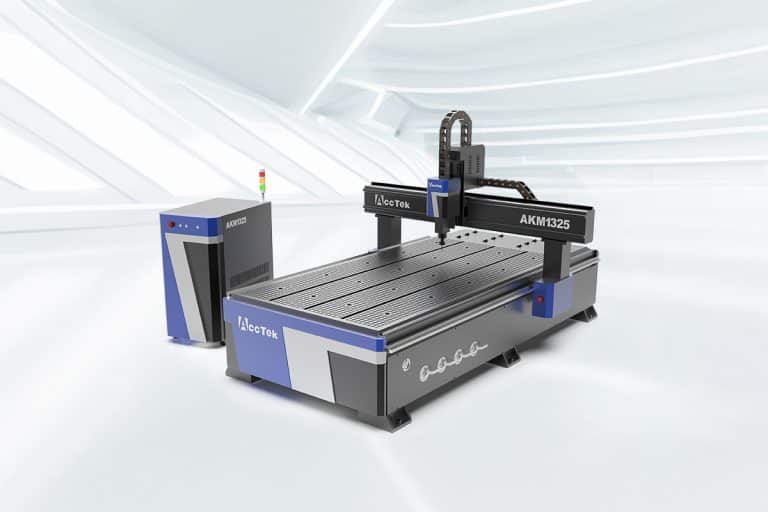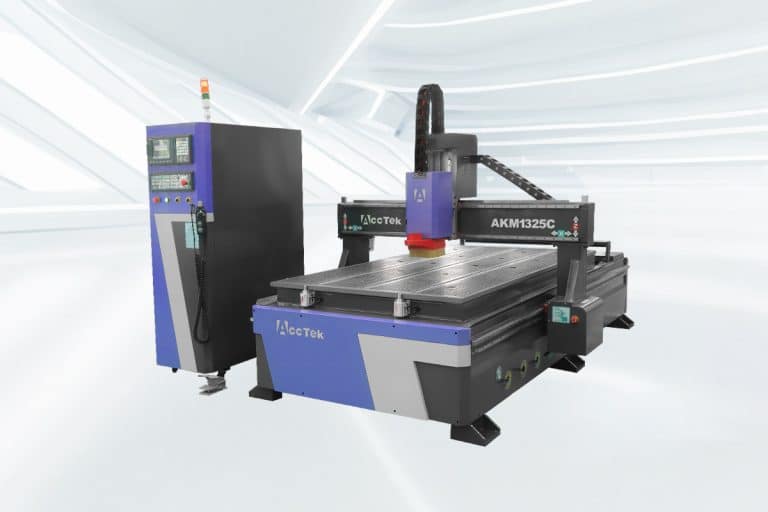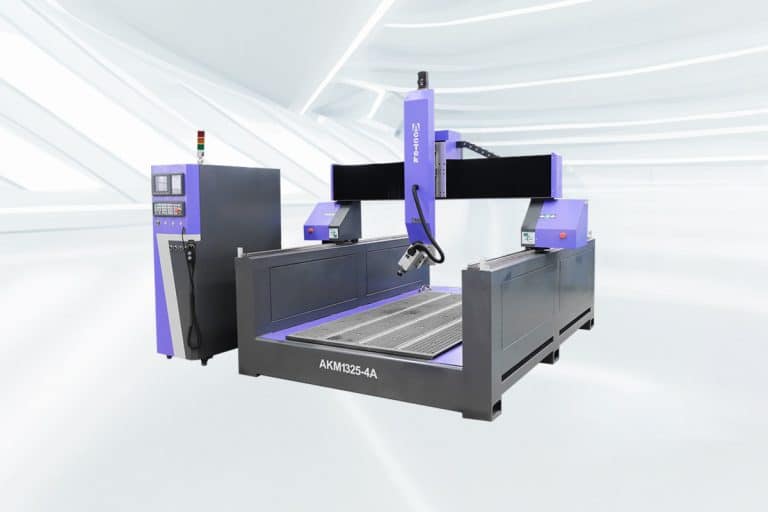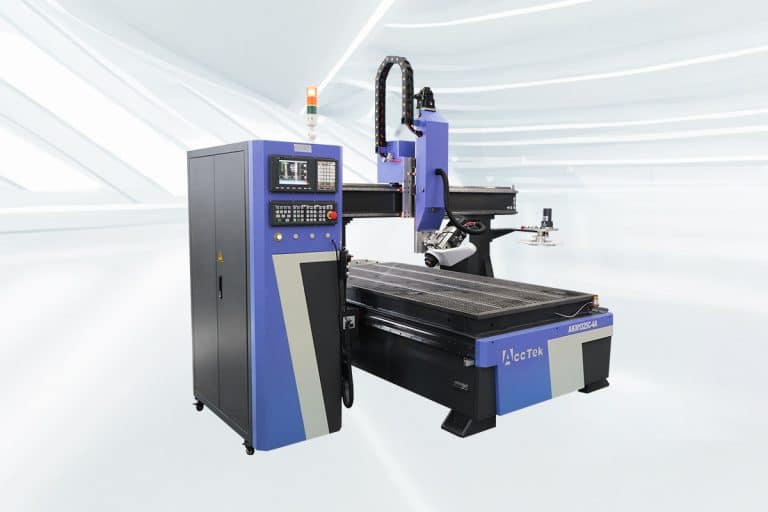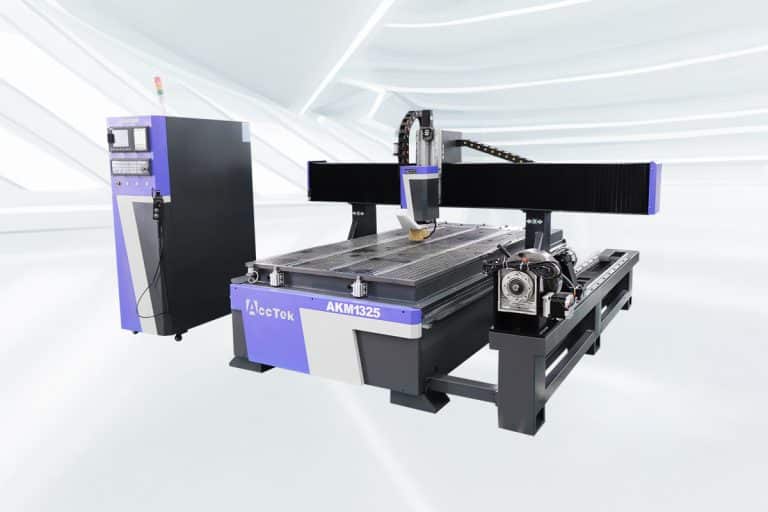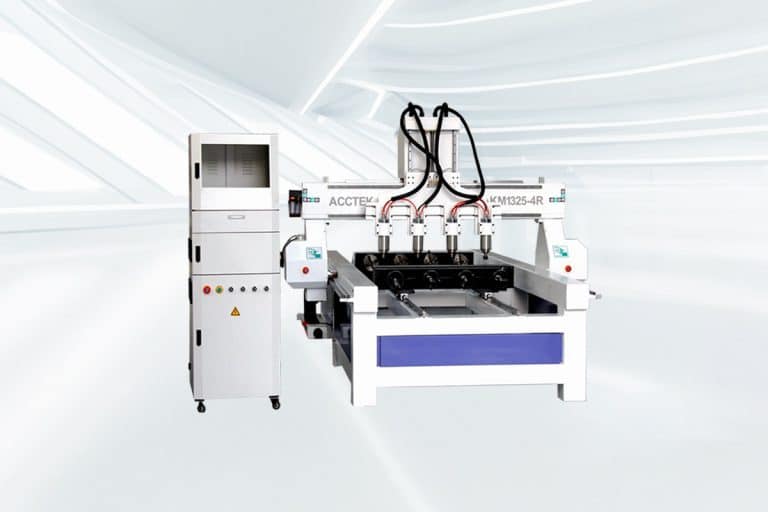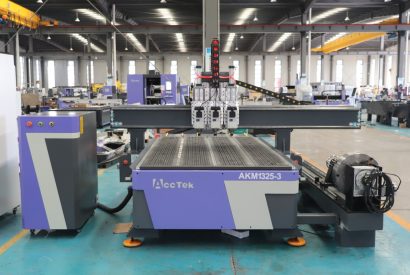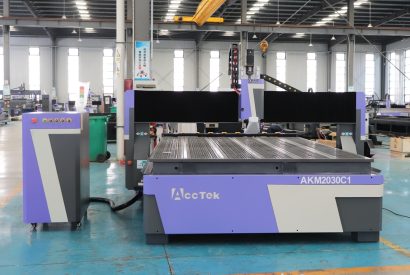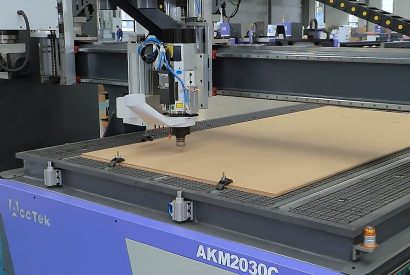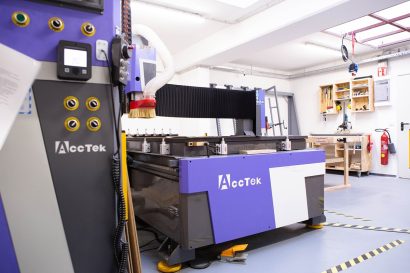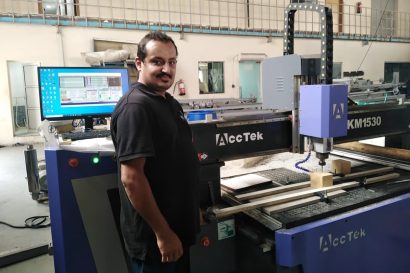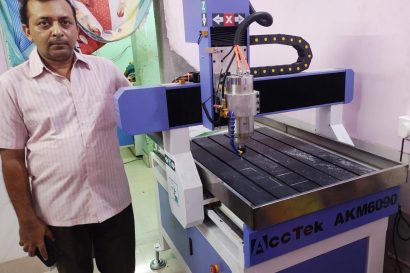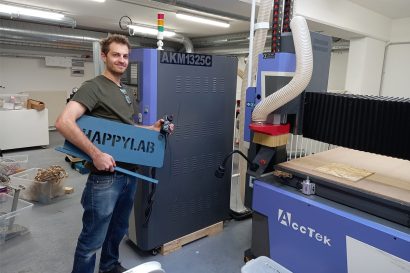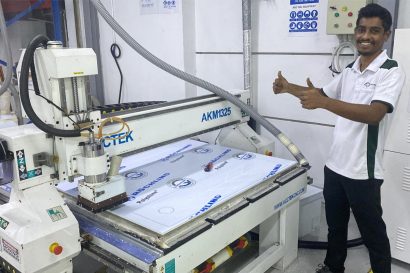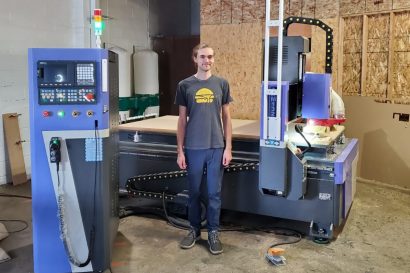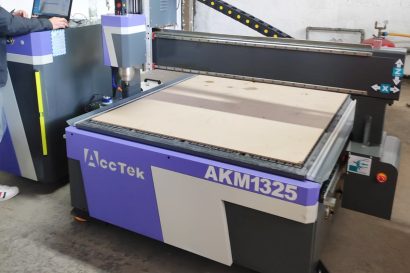1325 CNC Router
The 1325 CNC router is a powerful, versatile machine designed to meet the needs of professionals and businesses across a range of industries. With a generous working area of 1300 x 2500 mm, this CNC router is ideal for handling large materials, making it perfect for furniture making, signage, cabinetry, prototyping, and other precision machining tasks. Built with a robust frame and advanced components, the 1325 CNC router offers exceptional stability and reliability. Its high-performance spindle and efficient motion control system ensure smooth operation and precise cutting, even for intricate designs or heavy-duty projects. This router excels in processing materials like wood, acrylic, plastics, composites, and even soft metals like aluminum.
Equipped with user-friendly software compatibility, the 1325 CNC router allows seamless integration into any workflow, from design to production. Its flexible configuration options, including upgrades like vacuum tables, rotary axes, and automatic tool changers, make it a versatile solution capable of adapting to evolving needs. Whether you’re a small business owner looking to expand production capabilities or an industry professional in need of consistent, high-quality results, the 1325 CNC router delivers unparalleled performance and efficiency. With its precision, durability, and versatility, this machine is the perfect choice for taking your projects to the next level.
Tips for Choosing the Right 1325 CNC Router
Choosing the right 1325 CNC router is a crucial decision for ensuring precision, efficiency, and versatility in your machining operations. Whether you’re cutting wood, plastic, or composite materials, selecting a router that aligns with your needs will maximize productivity and ensure long-term value.
Define Your Application Needs
Understand the specific tasks you’ll use the 1325 CNC router for, such as cutting, engraving, or 3D carving. If you’re working with materials like wood, acrylic, or composites, ensure the CNC router is designed to handle these efficiently. The CNC router’s power, precision, and compatibility with different materials should align with your project requirements.
Assess the Work Area Size
The 1300 x 2500 mm cutting area of the 1325 CNC router is ideal for larger projects, such as furniture panels or signage. Ensure this size meets your typical material dimensions. For oversized projects, confirm that the CNC router can handle tiling or sectional cutting to expand its effective working capacity.
Check Spindle Power and Performance
Spindle power is critical for processing different materials. High-power spindles are necessary for dense materials like hardwood or aluminum, while moderate power is sufficient for softer materials. Additionally, check for adjustable spindle speeds to accommodate varying material needs for smoother cuts and longer tool life.
Evaluate Build Quality
A robust steel or aluminum frame ensures stability and minimizes vibrations during operation. This is especially important for heavy-duty or high-speed applications, as a sturdy build maintains cutting accuracy and extends the router’s lifespan. Durable construction also reduces maintenance and repair costs over time.
Consider Software Compatibility
Ensure the CNC router is compatible with popular CAD/CAM software. Software compatibility simplifies the design-to-production process and allows seamless integration into your workflow. Intuitive software options with user-friendly interfaces can make a significant difference, especially for operators with less experience.
Prioritize Precision and Accuracy
For detailed work, such as engraving or intricate patterns, precision is paramount. Look for CNC routers with advanced motion control systems and minimal runout to achieve high accuracy. Precision and repeatability are also critical for ensuring consistent results across multiple identical projects.
Review Accessory Options
Expandability is an essential feature of the 1325 CNC router. Check for support for accessories like rotary axes for cylindrical machining, vacuum tables for material holding, or automatic tool changers (ATC) for streamlined operations. These upgrades enhance the CNC router’s versatility and future-proof your investment.
Think About Maintenance Requirements
Choose a CNC router with straightforward maintenance processes. Machines with accessible components and easy-to-replace parts minimize downtime and ensure smooth operations. Regular upkeep, like cleaning and lubrication, should be easy to perform without needing specialized tools or excessive expertise.
Inspect Dust Management Systems
If you’re working with wood or other debris-generating materials, a dust collection system is essential. Dust management keeps the work area clean, protects sensitive machine components, and ensures operator safety. Look for routers that integrate well with external dust collection systems or have built-in options.
Analyze Speed and Efficiency
For high-volume production, speed is a critical factor. A fast cutting and travel speed ensures quicker project completion without sacrificing quality. Evaluate the machine’s rapid traverse rates and cutting capabilities to determine if it aligns with your productivity goals.
Ensure User-Friendliness
The 1325 CNC router should be easy to operate, even for beginners. Look for features like an intuitive control panel, clear instructions, and access to tutorials or customer support. A user-friendly machine reduces the learning curve and improves overall efficiency.
Balance Budget with Features
Set a budget and prioritize features that are critical to your projects. The 1325 CNC router offers a range of configurations, from basic models for entry-level users to advanced setups with premium features like ATC or rotary attachments. Balance affordability with long-term performance and expandability to get the best value for your investment.
What Materials Can the 1325 CNC Router Cut?
The 1325 CNC router is a highly versatile machine capable of cutting and engraving a wide range of materials with precision and efficiency. Designed for both soft and hard materials, it is ideal for applications in woodworking, metalworking, signage, and prototyping. The CNC router can handle wood, plastics, acrylics, composites, and soft metals like aluminum, making it a versatile solution for diverse industries.
With its powerful spindle and advanced motion control, the 1325 CNC router delivers accurate and consistent results, whether working on intricate designs or heavy-duty projects. Its large working area accommodates sizable materials, making it perfect for crafting furniture, cabinetry, and large-format signs. This adaptability makes the 1325 CNC router an excellent choice for businesses and professionals seeking high-quality performance across a variety of materials and applications.
Application Industry

Construction Industry
The integration of CNC routers into construction workflows has ushered in a new era characterized by meticulous detailing, rapid prototyping, and improved material utilization.

Aerospace Industry
The CNC router is widely used in aerospace engineering due to its unparalleled ability to carve complex designs, manufacture complex parts, and ensure tight tolerances.

Jewelry Industry
The CNC router revolutionize the way fine jewelry is designed and made by delivering unparalleled precision and efficiency and producing intricate designs with meticulous attention to detail.

Stone Carving Industry
The integration of CNC routers into the stone carving industry is not only revolutionizing the way craftsmen carve, it is also redefining the boundaries of artistic possibilities in this ancient practice.
Blog
Can CNC Routers be Upgraded or Expanded?
In this article, we'll explore the types of upgrades available for your CNC router, the benefits they bring, and the considerations before modifying the CNC system to help you get ...
Read More
How Do I Set Up My CNC Router for the First Time?
This article provides a step-by-step guide to help you through your initial setup process—from unboxing and assembling the machine to installing software, calibrating axes, and running your first test job.
Read More
How Does a Rotary Axis CNC Router Differ From a 4-Axis CNC Router?
This article explores how these rotary axis CNC routers and 4-axis CNC routers differ in structure, functionality, and application, helping you decide which is best suited for your production needs.
Read More
How to Optimize CNC Router Toolpaths for Fast Production of Signage?
In this article, we will explore how to effectively optimize CNC router toolpaths specifically for the fast production of signage to improve productivity and consistency in their signage projects.
Read More
Frequently Asked Questions
What Are 1325 CNC Routers Used For?
1325 CNC routers are versatile machines designed for a wide range of applications across various industries. With a large working area of 1300 x 2500 mm, these routers are particularly suited for handling large-format projects and materials.
In woodworking, 1325 CNC routers are used for crafting furniture, cabinetry, doors, and decorative panels with intricate designs. They excel in the signage industry for producing high-quality 2D and 3D signage, engravings, and intricate lettering. The machines are also widely utilized in prototyping and manufacturing, handling materials like wood, plastics, and composites to produce parts, molds, and custom components with precision.
Whether for hobbyists or professionals, 1325 CNC routers deliver efficiency, accuracy, and versatility, making them a reliable choice for businesses in furniture making, construction, advertising, and custom fabrication.
What Types of 1325 CNC Routers Are There?
1325 CNC routers are available in various configurations, each designed to meet specific machining needs. Here are the main types:
- 3-Axis CNC Router: This entry-level machine operates along the X, Y, and Z axes, making it ideal for 2D cutting, engraving, and simple 3D work.
- ATC CNC Router (Automatic Tool Changer): Equipped with a tool-changing system, this type increases efficiency by automatically swapping tools for different tasks, perfect for high-volume or complex projects.
- 4-Axis CNC Router: This model includes a rotating spindle or additional axis, allowing it to handle more intricate designs like cylindrical objects and angled cuts.
- 4-Axis ATC CNC Router: Combining a 4-axis design with automatic tool changing, this machine is suitable for detailed 3D work and multitasking, streamlining production processes.
- 5-Axis CNC Router: The most advanced type, offering simultaneous movement across five axes for multi-dimensional cutting, making it perfect for complex, professional-grade projects.
- Rotary Axis CNC Router: Specialized for cylindrical machining, this router is ideal for creating rounded objects like table legs, columns, or intricate sculptures.
How Much Are 1325 CNC Routers?
The cost of 1325 CNC routers depends on their type, features, and capabilities. Below is a breakdown of the price ranges for various models:
- 3-Axis CNC Router: Prices range from $3,000 to $6,500, ideal for basic cutting and engraving tasks.
- ATC CNC Router (Automatic Tool Changer): Ranging from $6,000 to $20,000, these models offer improved efficiency and multitasking capabilities.
- 4-Axis CNC Router: Priced between $10,000 and $18,000, these machines add a rotational axis for more complex designs.
- 4-Axis ATC CNC Router: Combining 4-axis functionality with automatic tool changing, these routers cost between $19,000 and $25,000.
- 5-Axis CNC Router: The most advanced option, designed for complex, professional projects, costs between $55,000 and $70,000.
- Rotary Axis CNC Router: Specially designed for cylindrical machining, these routers range from $5,000 to $15,000.
What is the Spindle Power of 1325 CNC Routers?
The spindle power of 1325 CNC routers varies based on the type and intended use of the machine. Here’s an overview of the spindle power for each model:
- 3-Axis CNC Router: Features spindle power between 3.0 and 3.5 kW, suitable for basic cutting and engraving tasks.
- ATC CNC Router (Automatic Tool Changer): Equipped with a 9.0 kW spindle, providing high efficiency for complex projects.
- 4-Axis CNC Router: Offers spindle power ranging from 6.0 to 9.0 kW, capable of handling intricate and heavy-duty operations.
- 4-Axis ATC CNC Router: Comes with a 9.0 kW spindle, combining rotational machining with tool-changing efficiency.
- 5-Axis CNC Router: Features a powerful 10.0 kW spindle for advanced, multi-dimensional machining tasks.
- Rotary Axis CNC Router: Equipped with spindle power between 2.2 and 3.5 kW, optimized for cylindrical work like table legs and sculptures.
How Precise Are 1325 CNC Routers?
1325 CNC routers are known for their high precision, making them suitable for a wide range of applications, from intricate designs to large-scale fabrication. The level of precision depends on the specific model and build quality:
- Standard Models: Achieve a precision of ±0.05 mm, ideal for general cutting, engraving, and woodworking tasks.
- Advanced Models (ATC, 4-axis, 5-axis): Offer a higher precision of ±0.02 mm to ±0.03 mm, enabling detailed engraving, 3D carving, and complex multi-dimensional projects.
Do 1325 CNC Routers Support Adding Accessories?
Yes, 1325 CNC routers support a wide range of accessories, enhancing their versatility and adaptability for various applications. The specific accessories available depend on the router model but may include:
- Rotary Axis Attachments: For cylindrical machining, such as creating table legs or sculptures.
- Vacuum Tables: To securely hold materials in place during cutting.
- Automatic Tool Changers (ATC): For seamless tool switching in complex projects.
- Dust Collection Systems: To maintain a clean workspace and protect machine components.
- Mist Coolant Systems: For efficient cooling when cutting metals or composites.
- Upgraded Spindles: For increased power and cutting capability.
What Customer Support Do 1325 CNC Routers Provide?
1325 CNC routers come with reliable customer support options to ensure smooth operation and user satisfaction:
- Free Online Technical Support: Customers can access complimentary technical assistance through online platforms, including email, chat, or video support. This service is ideal for troubleshooting, software setup, or resolving operational issues remotely.
- Paid On-Site Training: For users requiring hands-on guidance, on-site training sessions are available at an additional cost. These sessions cover installation, operation, and maintenance to ensure optimal use of the machine.
What Is The Warranty Period of 1325 CNC Routers?
Our CNC router is backed by a comprehensive warranty designed to give you peace of mind and protect your investment:
- 3-Year Warranty for the Entire Machine: This full warranty covers any defects or malfunctions in the machine as a whole, ensuring reliable performance and longevity over time.
- 5-Year Warranty for Core Components: Key components essential for optimal machine operation are covered for 1.5 years. This includes parts that may experience wear and tear with regular use, ensuring you have support for the most vital parts of the machine.

